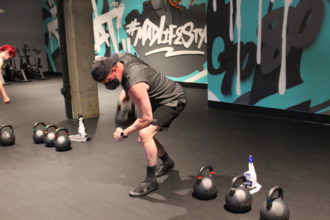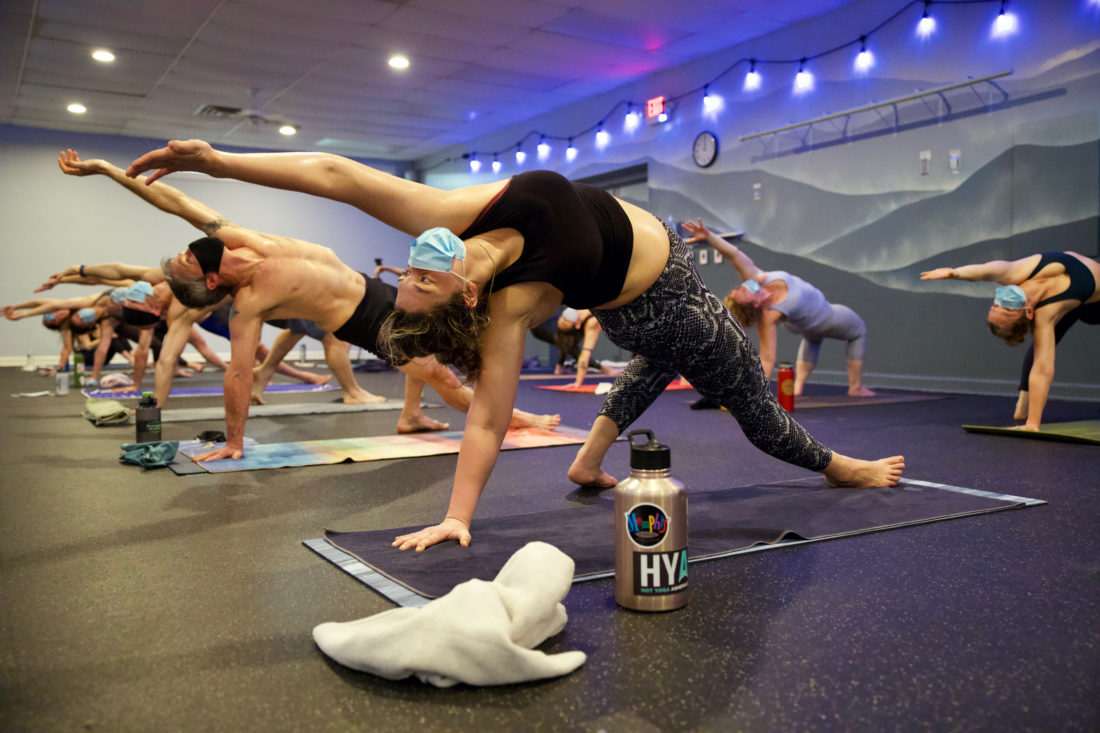Rap music blares and weights clang as the 14 gym enthusiasts signed up for MADabolic Asheville’s Monday afternoon class begin the day’s workout. Spaced 6 feet apart at stations marked either by tape on the floor or by free-standing exercise equipment like punching bags and standing rowing machines, they take their places as the big clock on the back wall slowly counts down.
Three, two, one…
With an explosion of power, the class jumps into action, lifting and punching through a series of interval exercises until the clock shows it’s time for a quick break. The participants begin to sweat, shiny droplets sliding down their foreheads and dripping onto the elastic straps holding their face masks in place.
This is a workout in March 2021, where face coverings are mandatory and members are continually asked to sanitize all equipment with a hand towel brought from home. But if that’s the price of in-person exercise these days, gym members like Daniel Windham are more than willing to comply.
“At first I was really nervous about stepping back into the same room as other people,” says Windham, who resumed attending in-person classes at MADabolic last fall. “Because of the way they run the operation here, I felt confident it would be safe. And I’m really glad I came back, because the mental and physical health benefits I get are extremely beneficial.”
Back in the saddle
The N.C. Department of Health and Human Services officially cleared state gyms to reopen for indoor in-person exercise at 30% capacity in early September. But a number of gyms had already reopened more than two months before, citing a loophole in Gov. Roy Cooper’s executive order that allowed indoor fitness facilities to serve people who need regular exercise as part of a medical treatment plan.
The governor’s latest executive order, in effect through Friday, April 30, allows gyms and fitness centers to open at 75% capacity indoors and 100% capacity outdoors.
For Hot Yoga Asheville, closing in-person operations meant losing the studio’s main draw: far infrared heaters that create the workout’s signature heat. The studio reopened as soon as state guidelines allowed, says owner Adi Westerman. In the interim, she and her team of yoga instructors created an online database of more than 300 videos for members to do at home.
“We’ve tried to make the best out of this weird situation, and people have been really responsive,” she says. To her knowledge, the studio has remained COVID-19 free throughout the pandemic. “Now I’m getting people emailing and texting me saying they’re getting their vaccines, so it’s starting to feel like there’s light at the end of the tunnel.”
No COVID-19 cases have been traced thus far to any YMCA facility in Western North Carolina, noted MaryO Ratcliffe, vice president of marketing and communications for the YMCA of WNC, in an email. Despite more than a million in-person visits to 96 YMCA facilities across the state in December and January, only 38 cases of COVID-19 were reported to YMCA officials, reports the North Carolina Alliance of YMCAs, yielding a positivity rate of .0038%.
To keep that transmission rate at zero, all WNC YMCA locations are screening members for COVID-19 symptoms before entry, regularly cleaning all equipment and focusing on low-touch interactions. New air filtration systems were installed, and some classes are held outside to minimize indoor contact.
But not everyone is coming back. Since March 2020, membership rates at area YMCAs have declined by 44%, Ratcliffe said. Roughly 35% of members are actively visiting facilities each month, she noted, and many more are taking advantage of virtual and on-demand classes. As COVID-19 vaccination rates increase, the chain expects to see participation rise.
“We’re excited that Cooper is increasing our occupancy to 75% and are confident that we’ll be able to continue to serve our members safely,” Ratcliffe said.
What does science say?
While local gyms claim low or nonexistent COVID-19 transmission rates, conflicting national studies tell a more nuanced story. Researchers from the federal Centers for Disease Control and Prevention published two reports in February detailing high coronavirus transmission rates during group exercise classes in Chicago and Honolulu, infecting 55 and 21 people, respectively.
The Chicago outbreak, which infected 68% of fitness class attendees over an eight-day period, was traced back to a patron who removed a mask during a workout. In Honolulu, a fitness instructor taught a stationary cycling class without wearing a mask; a few hours later he began experiencing COVID-19 symptoms. Contact tracing later revealed that everyone in the 10-person class had been infected, as well as several others who attended the instructor’s classes at nearby facilities in the days leading up to the onset of his symptoms.
Unlike the guidelines in place in Chicago and Honolulu at the time of the outbreaks, face coverings are currently required for all North Carolina gymgoers ages 5 and older. Some exceptions are allowed for those participating in an activity in which a mask could become a choking hazard or impair vision, such as swimming. Another exception applies to those who have a medical condition that makes wearing a face covering impossible.

Keeping a mask on during a workout isn’t as awful as people make it out to be, says MADabolic General Manager Jane Rakes. That is, ”until you’re breathing really hard and you end up breathing the mask into your mouth,” she laughs. “That’s the worst.” She’s found that exercise masks help, as do plastic inserts that keep face coverings from sticking to one’s face.
And constant face mask usage is likely helping to further condition gymgoers, Rakes adds. She compares face coverings with endurance masks professional athletes use to make oxygen intake more difficult during rigorous coaching sessions. “Our cardiovascular training and V02 max is going to be great by the end of this,” she says.
Can’t replicate it
While some people may see at-home workouts as a way to avoid health risks, extended time away from a gym has the potential to do more harm than good, Rakes believes. She’s noticed a number of clients attempting to return to pre-pandemic routines despite losing much of their strength in quarantine. Others are doing exercises using improper form.
“It’s likely that working out at home will eventually lead to injuries long term, just because you don’t have that set of eyes on you,” she says. “There’s only so much trainers can do to watch you or coach you over a Zoom class.”
Getting back to a gym environment can be deeply motivating, adds Danny Sharpe, owner of Biltmore Fitness. So much of working out is a mental challenge, he says, and for many people, the structure of a group exercise setting is key.
“I hear from so many people that they need the gym or fitness center to get the motivation to get moving,” he says. “It’s also about accountability. Is your workout partner or your trainer going to be there?”
For Windham, returning to MADabolic Asheville checked all of those boxes.
“I was kind of down and needed to take that first step toward something that made me happy before the pandemic,” he says. “It’s a decision I feel like a lot of people are making right now. People are weighing what’s important to them and what are the next steps needed to make that happen.”
Updated at 2:20 p.m. on March 31 to correct the type of heaters used at Hot Yoga Asheville.




Before you comment
The comments section is here to provide a platform for civil dialogue on the issues we face together as a local community. Xpress is committed to offering this platform for all voices, but when the tone of the discussion gets nasty or strays off topic, we believe many people choose not to participate. Xpress editors are determined to moderate comments to ensure a constructive interchange is maintained. All comments judged not to be in keeping with the spirit of civil discourse will be removed and repeat violators will be banned. See here for our terms of service. Thank you for being part of this effort to promote respectful discussion.